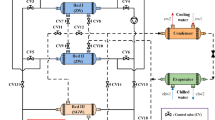Abstract
A novel silica gel-water adsorption chiller consisting of two adsorption/desorption chambers and an evaporator with one heat-pipe working chamber is experimentally studied. The dynamic operating characteristics of the chiller and the thermodynamic characteristics of the adsorber are obtained. The experimental results show that the dynamic operating characteristics of the chiller and the thermodynamic characteristics of the adsorber are satisfactory and that the cycle is a novel and effective adsorption cycle. A mass recovery process increases the cyclic adsorption capacity of the system and improves adaptability of the chiller to a low-grade heat source. In addition, the experiment indicates that this novel chiller is highly suitable for an air conditioning system with a low dehumidification requirement or a system with a large cycle flowrate and an industrial cooling water system.
Similar content being viewed by others
References
Lu Yunzhuang, Wang Ruzhu, Jiang Zhoushu, et al. Experimental analysis on performance of exhausted heat powered air conditioner used for internal combustion locomotive cab. Journal of Shanghai Jiaotong University, 2002, 36(10): 1385–1387 (in Chinese)
Jiang Zhoushu, Wang Ruzhu, Xu Yuxiong, et al. Simulation of adsorption air conditioner used in internal combustion lovomotive cabin. Journal of Shanghai Jiaotong University, 2002, 36(2): 176–179 (in Chinese)
Saha B B, Koyama S, Lee J B, et al. Performance evaluation of a low-temperature waste heat driven multi-bed adsorption chiller. International Journal of Multiphase Flow, 2003, 29: 1249–1263
Saha B B, Boelman E C, Kashiwagi T. Computer simulation of a silica gel-water adsorption refrigeration cycle-the influence of operating condition on cooling output and COP. ASHRAE Transactions Research, 1995, 101: 348–357
Boelman E C, Saha B B, Kashiwagi T. Experimental investigation of a silica gel-water adsorption refrigeration cycle-the influence of operating conditions on cooling output and COP. ASHRAE Transactions Research, 1995, 101: 358–366
Saha B B, Boelman E C, Kashiwagi T. Computational analysis of an advanced adsorption-refrigeration cycle. Energy, 1995, 20: 983–994
Saha B B, Koyama S, Kashiwagi T, et al. Waste heat driven dualmode, multi-stage, multi-bed regenerative adsorption system. International Journal of Refrigeration, 2003, 26: 749–757
Akahira A, Alam K C A, Hamamoto Y, et al. Mass recovery adsorption refrigeration cycle-improving cooling capacity. International Journal of Refrigeration, 2004, 27: 225–234
Liu Y L, Wang R Z, Xia Z Z. Experimental performance of a silica gel-water adsorption chiller. Applied Thermal Engineering, 2005, 25(2–3): 359–375
Author information
Authors and Affiliations
Corresponding author
Additional information
Translated from Journal of Shanghai Jiaotong University, 2006, 40(2): 306–310 [译自: 上海交通大学学报]
Rights and permissions
About this article
Cite this article
Wang, D., Wu, J., Wang, R. et al. Experimental research on dynamic operating characteristics of a novel silica gel-water adsorption chiller. Front. Energy Power Eng. China 1, 347–351 (2007). https://doi.org/10.1007/s11708-007-0052-4
Issue Date:
DOI: https://doi.org/10.1007/s11708-007-0052-4



